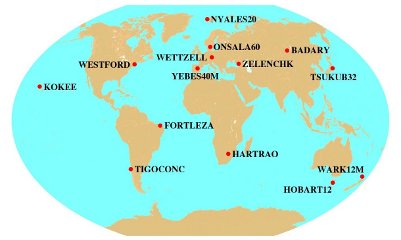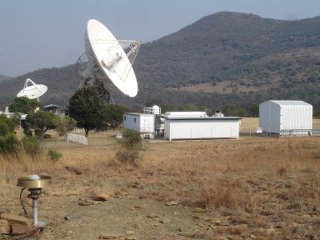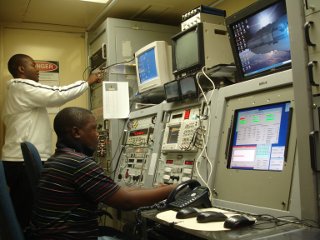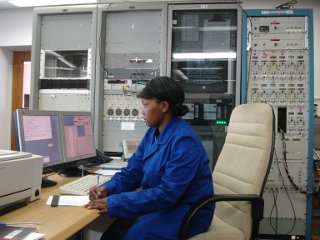
HartRAO Home >
news >
CONT11 two week continuous Geodetic VLBI 2011/09/15 - 2011/09/29
CONT11 two week continuous Geodetic VLBI 2011/09/15 - 2011/09/29
Every three years a major campaign is carried out to test the latest
advances in geodetic VLBI - precision position determination using
astronomical radio sources. 'VLBI' is short for Very Long Baseline
Interferometry, which means multiple radio telescopes observe the same
source at the same time and the data from each pair of telescopes are
combined to produce an interference pattern which depends on their position
on the Earth.
The official webpage on
CONT11 provides detail on the science that will be
obtained.
The CONT11 campaign comprises 15 day-long experiments.
Each experiment consists of many short observations of the distant quasars
that form the 'reference beacons' in space for determining the positions of
the radio telescopes involved to high precision.
The experiment on September 15, for example, had the HartRAO 26m antenna
carrying out 324 observations, providing 1.83 Terabytes of data. Thirty
three percent of the time was spent acquiring data while tracking on the radio
sources, 53% was spent
slewing from source to source across the sky, 4% was spent calibrating and only 9%
was idle time - the
lowest for any of the participating radio telescopes.
The IVS live website
provides real-time view of what is happening in the world of geodetic VLBI.
The CONT11 experiment was successfully completed on Friday 2011/09/29 at
02h00 local time. Only one of the daily scheduled hour long maintenance
periods was needed for the HartRAO telescope, to fix an intermittent wiring
problem. A total of 2.5 hours of data recording was lost to that and other
minor problems, from 360 hours of observing.
The participating telescopes are shown in the map below.

Left click on image for large version.
The 26m HartRAO telescope is the only VLBI-capable one in Africa. It has mutual
visibility with all the other telescopes except Kokee Park on Hawaii, which
is on almost the opposite side of the Earth. 'Mutual visibility' means that
the telescopes can observe the same radio source at the same time - an
essential requirement for VLBI. The telescope shown at Warkworth, New Zealand
dropped out owing to technical reasons. (Map courtesy of the International VLBI Service for
Geodesy and Astrometry).

Left click on image for large version.
Geodetic VLBI operations controller Marisa Nickola checks the progress of the VLBI on the first morning of
CONT11, seated at the VLBI control computer. The VLBI recording systems are
visible behind her.

Left click on image for large version.
The HartRAO 26m telescope is seen left of centre at 09h30 SAST slewing west from
radio source 1156+295 to 0727-115. In the left background is the 15m antenna
built as a prototype for the Karoo Array Telescope. It is being converted
to be able also to do geodetic VLBI. Its advantage over the 26m telescope
for this is its faster slew rate. Right of centre is another geodetic
instrument, the NASA MOBLAS-6 Satellite Laser Ranger, seen ranging to the
LAGEOS satellite. The SLR data are sent to the International Laser Ranging
Service. To its right is the roll-off observatory containing a new
laser ranger under development. In the left foreground is the small
circular Global Positioning System basestation antenna that supplies data to
the International Global Navigation Satellite System Service. These precise
position measuring systems are co-located with the radio telescope to
provide cross-referencing.

Left click on image for large version.
Inside the MOBLAS-6 SLR control van, Klaas Ramaoka is seen in the foreground
optimising the tracking of the LAGEOS satellite. SLR Technical Manager Lusanda Ntsele,
standing behind him, checks the SLR equipment.

Left click on image for large version.
HartRAO electronics technician and VLBI operator Lerato Masongwa checks the air temperature
and weather around the radio telescopes.

Left click on image for large version.
Lerato notes the weather details at the VLBI terminal. Lerato took the
first night shift, and started up the VLBI at HartRAO at 02h00 local
time on September 15.

Left click on image for large version.
The HartRAO geodetic VLBI operations team. VLBI Manager Jonathan Quick
(foreground) briefs (from the left) Marisa Nickola, Ronnie Myataza, Lerato
Masongwa and Jacques Grobler.

